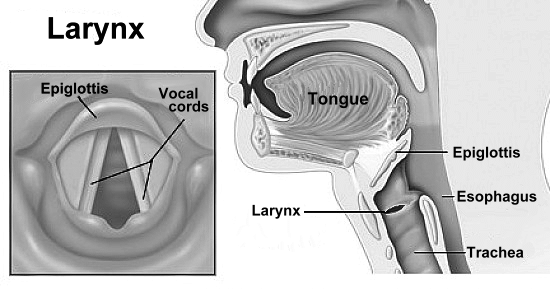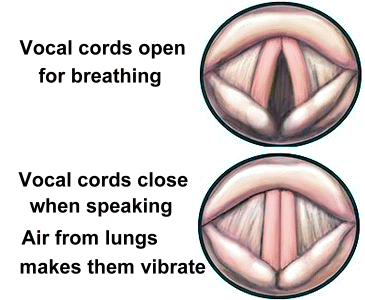 Your voice, whether it is speaking or singing, is produced by the vibration of the vocal cords, or 'vocal folds'. The vocal folds are a pair of pliable strips of tissue that stretch across the top of the trachea (breathing tube). They are protected by the thyroid cartilage, a hard structure that forms the 'Adamís apple'. The vocal folds and muscles and cartilages that support them are called the larynx.  The larynx evolved as a valve to protect the airway and lungs. It is located at the spot where the airway and the esophagus separate. The vocal folds open to allow breathing, and close during swallowing to prevent food from entering the lungs, They also close during speech.  The vocal folds have a V-shape, and are covered by a soft elastic lining called the mucosa that can vibrate at high speeds.
Ordinary voice production happens when the vocal folds meet completely in the middle; the lungs blow air against vocal folds that are closed, but more loosely than they would be during swallowing. Air pushes through the small space between them, making the mucosa covering the vocal folds vibrate.
The vocal folds have a V-shape, and are covered by a soft elastic lining called the mucosa that can vibrate at high speeds.
Ordinary voice production happens when the vocal folds meet completely in the middle; the lungs blow air against vocal folds that are closed, but more loosely than they would be during swallowing. Air pushes through the small space between them, making the mucosa covering the vocal folds vibrate.
This is the venturi effect. As air passes through a constriction (a 'venturi'), it speeds up and creates a suction behind it. This suction pulls at the mucosa from each vocal fold, which meet in the middle, only to be pushed aside by more air from the lungs. This cycle creates a repeating vibration that is very fast. The vibration produces sound. 
The volume of the sound produced depends on the pressure from the lungs; stronger lung pressure will increase the volume. Loudness requires the vocal folds to stiffen and come together completely. Pitch is the frequency of a sound. Pitch depends on the length and tension of the vocal folds; longer folds produce lower pitched sounds, while shorter folds make higher notes. This is why men, with longer vocal folds, usually have a lower pitch than women. The muscles in the larynx can change the tension of the vocal folds, tightening the muscles to increase pitch, and relaxing muscles to decrease pitch. |